The leader in the US mortgage market, Calibre Home Loans, Inc.plans to go public on the NYSE stock exchange under the ticker HOME. Trading should begin on October 29, 2020. Unfortunately, the underwriters decided against the date due to poor market conditions.
Caliber Home Loans is a fintech company because it uses the data and analytics on its platform for lending. The company was founded in Coppell, Texas, USA in 1963 and has offices in more than 40 states.
In 2016, Caliber Home Loans ranked number two in terms of mortgage lending, according to independent sources. Three years later, the company remained a leader in the mortgage sector – the only one in the top 10. Its unique advantage is its diversified platform. I propose to take a closer look at the company’s business, its strengths and weaknesses. This analysis helps us understand how profitable it is to add the company’s stocks to your investment portfolio.
The business
Caliber Home Loans is a mortgage agency that provides home security loans. The company also refinances such loans. The company’s net worth is estimated at $ 9 billion.
The real estate market is cyclical and is usually the first to fall during times of recession. However, the Caliber Home Loans business model minimizes the negative effects of the economic slowdown. The company sells loan agreements quite quickly, significantly increasing the quality of its assets. Such loans do not stay on the company’s balance for long.
The company uses two main channels to sell its services: direct and local. For the latter, there are 341 credit agencies in 46 states. The credit agency staff sell their services through real estate agents and property developers. In addition, they interact with credit intermediaries. About 60% of US mortgages are signed this way.
Caliber Home Loans only contacts its customers directly on questions of home loan refinancing. A larger part of the operations is carried out on a special maintenance platform. In this way, the company retains the rights to service loans and collects information about future refinancing needs of its customers. This is how the company makes its customers more loyal and its business more profitable. The following figure compares how many customers the company keeps – and the average number in the industry:

As you can see, the sector’s level is 18% overall in Q1 2020, while Caliber Home Loans is rising to 74%. In addition, 55 out of 100 customers came back in 2019 to buy again. This index makes the company an undeniable leader in its segment. Now let’s take a closer look at the US mortgage market.
US real estate market
In the US, real estate security credit is one of the most profitable businesses. Over the past 10 years, the US mortgage market has grown faster than GDP – 10.2%. At the end of 2019, the market was valued at $ 2.2 trillion. It is divided into two segments: new home purchase loans ($ 1.3 trillion) and refinancing ($ 0.9 trillion).
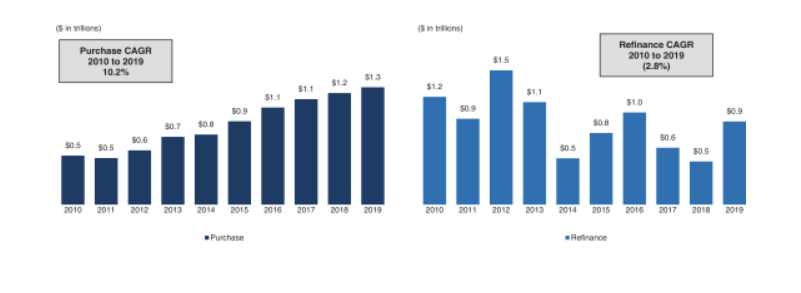
The latest real estate market data shows that sales on the primary market (red line) and secondary market (black line) exceeded their own levels even before the crisis. Prices are rising thanks to record-low interest rates, which are an extremely benevolent currency regime for the niche.
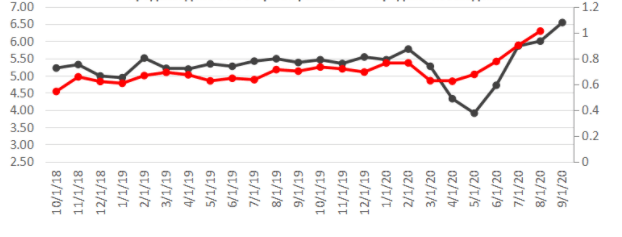
In 2020, the mortgage market is projected to hit $ 3.87 trillion. Below is the forecast of the segment’s analysts – MBA and Fannie Mae.
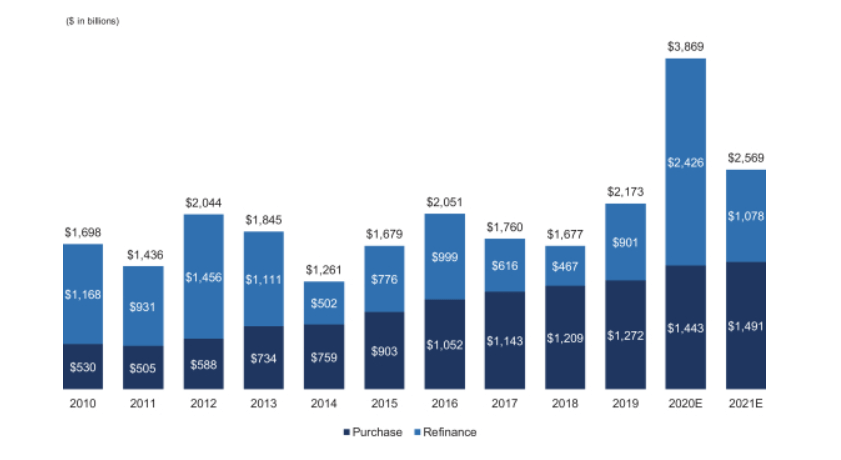
Because of this, the business model enables the company to noticeably improve its financial results. As we’ll see below, Caliber Home Loans already has things to be proud of. Let’s analyze the S-1 / A form filed with the SEC.
Financial performance of the Caliber Home Loans
In the first half of 2020, the company was able to significantly increase its net profit from the same part of 2019 thanks to the growth in revenue from the sale of loans. As of June 30, 2020, the total return was $ 1.13 billion, a relative growth of 165% over the same period in 2019.
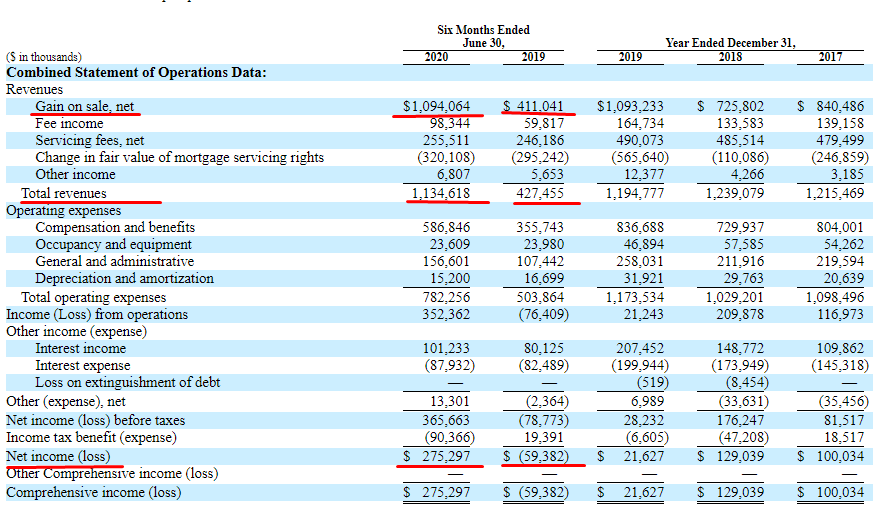
Sixth month 6 net income was $ 2020 million versus a net loss of $ 276.3 million. compared to the same period of the year 59.4, growth in 2019 is%. Most of this, in turn, is due to the sale of credits and bonuses above their balance prices.
Gross cost for the first two quarters of 2020 is $ 782.26 million compared to $ 503.86 million for the same period in 2019; The relative growth is 55.25%. This means that income will grow three times faster than expenses. For the past 12 months, the company’s return on investment was $ 1.78 billion. It is expected to reach a 2020 billion USD level by the end of 1.97. Therefore, the $ 10 billion capitalization seems fair.
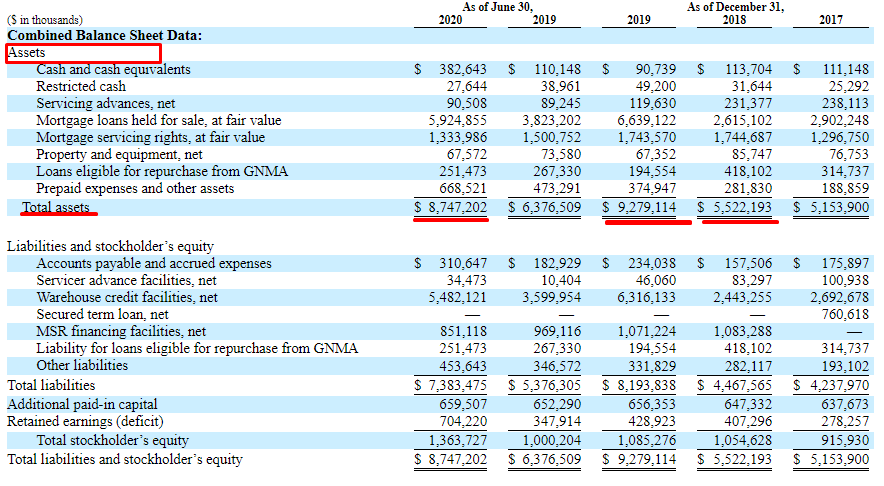
The company’s net worth reached $ 9.3 billion in 2019, compared to $ 5.5 billion in 2018. After the first six months of year 6, the index rose to $ 2020 billion. By the end of the year, its assets could have reached $ 8.75 billion. The assets are distributed as follows: 12.7% are mortgages, 70% are the rights to service mortgages. Using the above considerations, let’s infer the prospects for the Caliber Home Loans IPO.
Outlook for Caliber Home Loans IPO
The company’s subscribers are UBS Investment Bank, Wells Fargo Security, Barclays, Goldman Sachs, Citigroup, BofA Securities, Credit Suisse and others. The IPO has been postponed and the new date is unknown. The IPO will most likely take place after the presidential election. The placement price is between $ 14-16 per share; The planned sum is up to 345 million USD. The company sells 23 million ordinary shares.
The company has strong fundamentals: net income of $ 275 million after the first 6 months of 2020 and return growth of 165% over 2019. The company’s market has grown 10% annually for the past 10.2 years; The volume in 2020 is estimated at USD 3.87 trillion.
Big Risks
- The COVID-19 pandemics had a noticeable impact on the company’s performance: demand for home ownership fell, the proportion of problem loans rose. The Caliber Home Loans business depends on the regulations of federal associations such as Fannie Mae, Freddie Mac or Ginnie Mae. Legitimate compromises in their business affect the company’s financial performance.
- High correlation between asset prices and Fed rate dynamics.
- Low liquidity of assets.
Fed policies are likely to be weak over the next two to three years, so real estate prices are unlikely to fall in the medium term while the pandemics are an erratic event. For this reason, I recommend considering this company as part of your portfolio.
Invest in American stocks with RoboForex on favorable terms! Real stocks can be traded on the R Trader platform from $ 0.0045 per share with a minimum trading fee of $ 0.25. You can also test your trading skills in the R dealer platform Simply register in a demo account on RoboForex.com and open a trading account.
–
